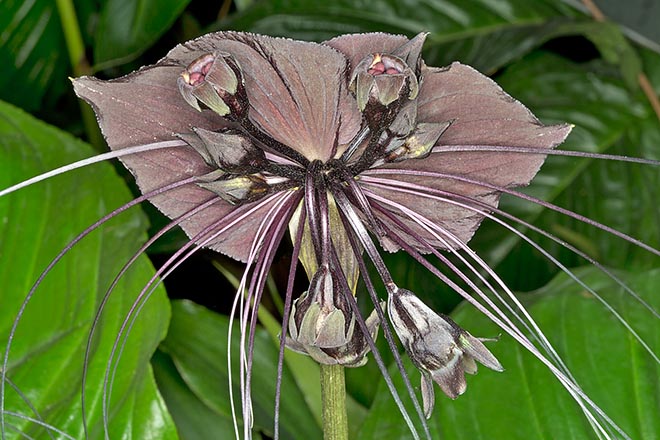Family : Dioscoreaceae

Text © Pietro Puccio

English translation by Mario Beltramini

Disturbing Tacca chantrieri inflorescence with 4 big bracts and many filiform © Giuseppe Mazza
The name of the genus comes from the Indonesian one “taka laoet” of the Tacca leontopetaloides; the species is honoured to the brothers Chantrier, XIX century French horticulturists.
Common names: bat flower, bat head lily, bat plant, black bat flower, cat’s whiskers, devil flower, voodoo flower (English); jian gen, shu (Chinese); plante chauve-souris, fleur du diable (French); fiore pipistrello (Italian); flor-morcego, flor negra, morcego-negro (Portuguese-Brazil); flor del diablo, bigotes de gato, flor murciélago (Spanish); Fledermausblume, Fledermauslilie, Teufelsblume (German).
The Tacca chantrieri André (1901) is an evergreen rhizomatous herbaceous species, usually 60-80 cm tall, with almost cylindrical, vertical, rhizome, up to 10 cm long and of 2 cm of diameter, basal simple leaves, on a 10-30 cm long petiole, oblong-elliptic with pointed apex and entire margin, 20-50 cm long and 7-25 cm broad, corrugated, of glossy olive green colour on the upper page, slightly paler below. Umbel inflorescence, on a 20-60 cm long floral scape, with 5-20 flowers subtended by 4 involucral bracts, the two external ovate-lanceolate, up to 9 cm long and 4 cm broad, and the inner ones ovate with wavy margin, up to 10 cm long and 5-9 cm broad, of blackish purple colour, accompanied by several filiform bracteoles, up to 20-25 cm long. Hermaphroditic flowers of about 3 cm of diameter, on blackish purple, 2-4 cm long, pedicel, with 6 ovate or almost triangular lobed peranthium with pointed apex, up to about 1 cm long, of purple brown colour, and 6 stamina. The fruits are purple brown berries, 3-4 cm long, containing numerous reniform seeds, about 0,4 cm long, immersed in a sticky pulp.

Rhizomatous, evergreen, can be 80 cm tall along the water ways in the South-East Asia humid forests rich of decayed organic material. Used in the Chinese traditional medicine for various pathologies © Giuseppe Mazza
Species with inflorescences standing among the most unusual and particular of the vegetal world, cultivable in the tropical and subtropical humid climate zones, in shaded location, around the 70%, and sheltered from the winds. It requires soils rich of organic substance, light, porous, well drained, slightly acidic or neutral and maintained constantly humid, but without stagnations, utilizable as soil cover or for edgings.
Elsewhere, it is to be cultivated in pot in order to be sheltered during the winter months in location even if not particularly luminous, using a perfectly draining organic loam which may be formed by 40% of medium-sliced pine bark fragments, 40% of peaty loam and 20% of agri-perlite or coarse siliceous sand, with diurnal winter temperatures of 18-22 °C and lowest ones not under the 15 °C, constant light ventilation, but avoiding the air currents, and high atmospheric humidity, 60-70%, not easy to be maintained in an apartment. To increase the humidity the pot may be put on a tray with pebbles or expanded clay granules maintained constantly wet and to frequently nebulise with non-calcareous water at ambient temperature, in order to avoid unsightly stains on the leaves. The waterings must be regular and abundant in summer, but carefully avoiding the stagnations, cause of easy rottenness, more spaced in winter, allowing the substratum to partially dry up before giving water again, and the fertilizations, in spring-summer, done with hydrosoluble balanced products for acidophiles with microelements at ¼ of the dosage suggested on the package. The repottings are to be done in spring at the time of the vegetative restart. The rhizomes are used in the Chinese traditional medicine for various pathologies.
Synonyms: Tacca macrantha H.Limpr. (1902); Tacca lancifolia var. breviscapa Ostenf. (1904); Tacca minor Ridl. (1907); Tacca vespertilio Ridl. (1907); Clerodendrum esquirolii H.Lév. (1912); Tacca garrettii Craib (1912); Schizocapsa breviscapa (Ostenf.) H.Limpr. (1928); Tacca paxiana H.Limpr. (1928); Tacca roxburghii H.Limpr. (1928); Tacca wilsonii H.Limpr. (1935); Tacca esquirolii (H.Lév.) Rehder (1936); Schizocapsa itagakii Yamam. (1942).
→ To appreciate the biodiversity within DIOSCOREACEAE family please click here.
